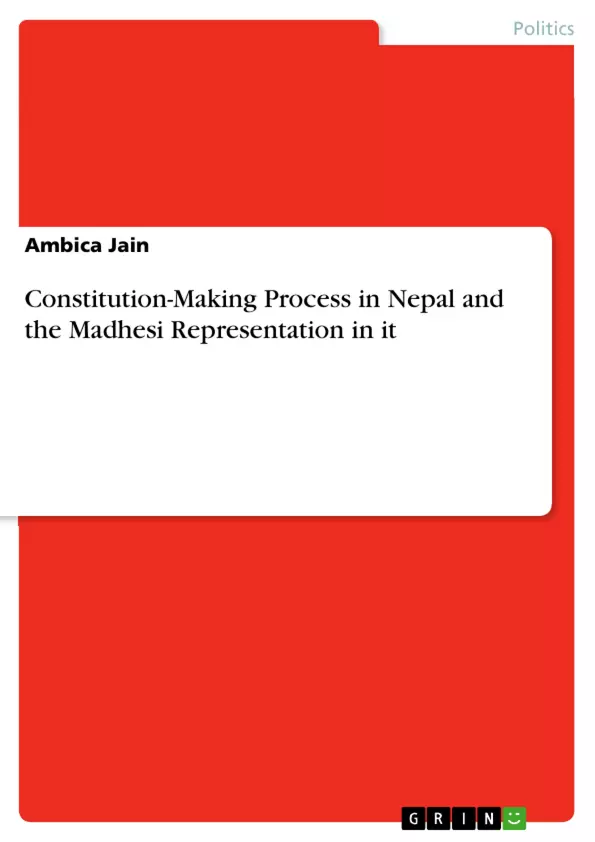Nepal, with the adoption and enforcement of a new constitution in 2015, entered into a new phase of development. The constitution adopted in September 2015 is the seventh constitution in Nepal. The constitution-making process has been a complex in Nepal. Nepal had to undergo several political turbulences and transformation before adopting this new constitution. The field report and the research paper aims to look into Nepal’s constitution-making process historically and understand and explain this process. In the process, it also will look at the concerns of Madhesis with regard to the constitution-making process and their representation in it. This research paper is broadly divided into two parts, the first part looks into the literature and provides the review of the literature that has looked into the aforementioned topic. The second part is the field report, wherein, through interviews, the first-hand accounts of people are collected and analyzed.
Inhaltsverzeichnis (Table of Contents)
- Introduction
- Part I
- Literature Review
- Historical Background
- Madhesis in Nepal
- The Constitution of 1990 and Madhesis
- Maoist Rebellion and Madhesi Mobilisation
- Interim Constitution of 2007
- The Constitution of Nepal 2015
- Literature Review
- Part II
- Field Report
- Methodology
- Findings and Observations
- Discussion
- Field Report
- Conclusion
Zielsetzung und Themenschwerpunkte (Objectives and Key Themes)
This research paper explores the complex constitution-making process in Nepal, focusing on the historical context and the role of Madhesis in shaping the 2015 constitution. It examines how the constitution-making process has been influenced by political events, movements, and the concerns of marginalized communities.
- Historical evolution of the constitution-making process in Nepal.
- The historical and contemporary challenges faced by Madhesis in Nepal.
- The inclusion and representation of Madhesis in the 2015 constitution.
- The role of political movements and activism in influencing the constitution-making process.
- The significance of federalism and inclusivity in the context of Nepali society.
Zusammenfassung der Kapitel (Chapter Summaries)
The first part of the paper provides a literature review, exploring the historical context of constitution-making in Nepal. It analyzes the various constitutions adopted by Nepal throughout its history, highlighting the challenges and transformations that have shaped its political landscape. The review also examines the identity and concerns of Madhesis in Nepal, discussing their historical experiences of marginalization and their role in the constitution-making process.
The second part of the paper presents a field report, based on firsthand accounts and interviews conducted in Nepal. This section delves into the contemporary issues and challenges faced by Madhesis, focusing on their perspectives on the 2015 constitution and the extent to which it addresses their concerns.
Schlüsselwörter (Keywords)
The paper focuses on the key concepts of constitution-making, federalism, inclusivity, Madhesi representation, marginalized communities, political transformation, and historical analysis in the context of Nepal. The study also examines the impact of political movements, such as the Maoist rebellion, on the constitution-making process and the role of Madhesis in shaping the political landscape of Nepal.
- Arbeit zitieren
- Ambica Jain (Autor:in), 2017, Constitution-Making Process in Nepal and the Madhesi Representation in it, München, GRIN Verlag, https://www.grin.com/document/441763



